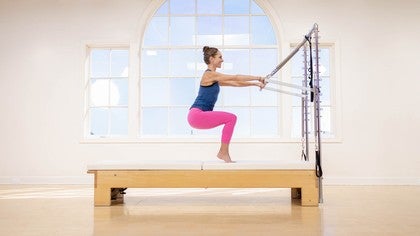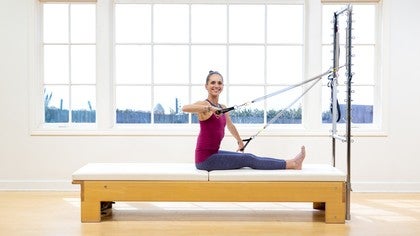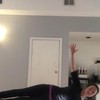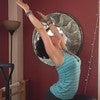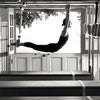Description
About This Video
Transcript
Read Full Transcript
Hi everyone, I'm excited to be here with you today. We are going to do some work on the tower. So there's some things to get organized before we get started. And as you probably know, working on the tower oftentimes will require spring changes and things like that. So I'm just gonna tell you what I have at the ready so that you can have that at the ready and then we'll change in real time together.
Yeah, so what I have here are a pair of handles. You don't have to, if you prefer a strap, I just like them, they're nicer to hold. We're gonna do some rotational work, shoulder rotational work. I also have the roll up bar with two yellow springs. If I put it on now, it will be in the way.
So I'm gonna put it back here. (springs clanging) Pardon in the noise of the springs. Additionally, I've got long purple springs on the tower about yay high from the mat. So because some towers are on the ground, as you know, you'll have to organize your springs accordingly. And then on the top here, I have one blue and one red.
I think that's all you need to know. Are you ready? Me too, so what we're gonna do, you could work with two blues on top or two reds on top, whatever. I just like this most because I want the option of either a red or a blue spring. So we are going to stand on the tower.
Holding onto the bar, standing far enough away from the bar so that your arms can reach straight forward for the bar without bending. And then we're going to do a little downward push on the bar, I'm not actually moving the springs, I'm just starting to organize my body, my shoulder blade, my awareness. Take a breath in. As you exhale, let your head nod to your chest. And then you're gonna start to roll down.
Now this is a heavy spring, so if it's too heavy, you'll just make your own choices. I'm tucking my pelvis as I go down. So pretty active through the back of the legs. I'm taking my spine down, inflection straight down, leaning into the weight of the springs, going down, going down going down and pausing, deepening into that shape. And on the exhale, I'm gonna push down with my arms, push down with my legs and use those four points of contact to create depth of connection in the center of the body.
And then we come up to standing all the way up. And inhale, we'll do three. Exhale, nod the chin into the chest, allow the weight of the body really just to push the springs down. Nice heavy spring, I find it very supportive and comforting somehow. Head drops down between the arms.
Arms will get a little bit forward of the head. That's okay, and inhale. And then exhale, push down into the spring and really use the weight of that spring to support the shape and allow you to work the spine through that full range. Eyes come up, inhale. And last one like this, rolling down.
I allow my hands to glide around the bar as they need so that my wrists stay aligned with my arms rather than bending my wrists ever. And inhale and lifting back up. Letting the weight of the springs push up into the hand, deepen into the center of the body. So that was number three. Look at her, she can count to three.
Well done, teach. Let's go down again. This time instead of staying round, we're gonna take the body out long. So down into like a flat back elephant shape or an upstretched shape. And then reround the spine and roll up.
Two more like that, inhale. Exhale, lean into the spring. Deepen into the center of the body. Use this as your abdominal warmup and your spinal warmup and your basic warmup. Checking in, mentally connecting.
Take the spine out long. Feel the weight of your body biasing towards the heels. And then curl the body, rolling the spine, moving the body with the equipment, and inhale. And last one, rolling down. Finding flexion, it's like a pike.
And then extending. Now that flat back is difficult for me. I imagine it's difficult for a lot of people. You could bend your knees and really lift the spine even straighter if you need. And then round.
Rolling the spine up. Standing up tall, we're going straight into some legwork. So what we're gonna do is we're gonna sit back. I'm keeping my arms straight, using the support of the springs to sit down nice and low, push through the heel, stand all the way up and bend. Inhale, feeling the connection of the heels to the back of the thigh.
If this doesn't feel good to your knees or anything else, you can choose your own range and stand, thinking about keeping the tracking of the knee and the hip aligned, and stand. It's a nice low squat for me. I enjoy the ability to get down into that deep knee flexion, and up. We'll do two more, bend, and up. One more, bend, and up.
Rising the heels, lifting the heels so you don't have to be right up on your tip tippy toes, but just like a fairly neutral ankle, similar to how you would be in for your footwork. So that as the knees bend, we allow the ankles to pivot a little, feet stay still and stand. And I'm leaning back with my pelvis, leaning back away from the bar with my body and stand. Creating the work that we wanna bring into this experience. What I mean by that is finding connection, squeezing the inner thighs, what's happening in the abdominals?
Where are the shoulders on the back? Lots of things to consider. We'll do four more. I'm not using my arms too much, but I do feel them. I'm just bringing the bar with me as I go down.
Three, two and one, sitting back, coming up. Swiveling from the hips to bring the heels into a small V shape. Squeeze the heels together, bend the knees, let them separate as you squat down and stand up and bend. Great preparation for the Russian squats. And stand up and bend.
And stand up and bend. So I'm thinking here about keeping my spine aligned over my pelvis. Going straight down like there's a wall behind me, four more. It's actually harder at the top for me where this brings let go, and three, and two, and one. Separate the heels, lower them down, lift them up.
Bend one knee, lift both and change, and up and down, actively pulling the arms or pushing down with the arms. And up, stretching the toes, and up, and down, and three, and down, and three, and down. Feel buoyant as you lift the one foot, lifting up and down. I think one more, and down, and up, and down. Both feet up, both feet down.
Come down onto your knees. Bring the elbows wide to the sides. Orient the knees so they're just underneath the hips. Feel a little bit of support from the back of the thighs here, the hamstrings. Take the arms down, it's heavy and bend.
Resist the springs as you come up, take the arms down and bend the elbows wide but think of pointing them slightly down, not a lot down. Just biasing towards external rotation in the shoulder joint itself. And bend, pulling apart on the bar. Just a energetic cue. Think about that a lot actually, like the spreading of the hands in relationship to where the shoulder blades are.
So it's more of a back cue than a hand cue. Press, resist, how about two more? Press, resist, like a kneeling pushup kind of, I dunno, in my imagination anyway, resist. Take the springs away. The bar's gonna go away.
Here's where we're gonna need to collect the roll up bar. And I am putting it on the tower about shoulder height when I'm on my knees. We're gonna sit down, straddling the tower. Of course you can always choose the tension in the springs by either going forward or back with your body. Keeping the arms straight, we're gonna do a little seated chest lift, seated forward flexion.
Feel yourself sitting right over the top of your sitting bones. The pelvis doesn't change. As we exhale, we lift the spine up and then take the upper body down and then use the abdominals to lift the spine back up. And inhale and exhale, bending the spine. One of those exercises where you have to put the work that you wanna feel in.
So find the connection to the body. Use that deep connection to pull the spine into flexion. I'm not pushing with my arms so much as I'm just bending my spine and allowing my arms to come with me. So there is a little arm work 'cause we're pulling spring but it's mostly ab work. We're just gonna do one more.
Great exercise, I really enjoy it. Next we are going to take rotation, squeeze the tower with your legs, keep the legs still and turn, bring the arms with you, and center and feel the spine lifting up as you keep the bar right in front of your chest and rotate from the spine. And one thing that's nice, continue to alternate from side to side, one thing that's nice about the leg position is as you take rotation, if you're really focusing on that inner squeeze with the thighs, you'll be able to feel if it shifts or I can feel if I shift. So is one sitting bone lifting off? Can you feel one knee letting go a little?
We're maximally rotating the spine, and center, and maximally rotating the spine and center. We'll do two more here. Turning and center, and turning and center. After this one we're gonna make a combination of those two movements. So this will be it.
And now we're gonna find our rotation, take flexion. Come up in rotation, find the center, go into your rotation, feeling the ribs rotate. Draw in on the abdominals. Use the bend of the spine to apply pressure on the springs. Come up in rotation, resisting the weight of the springs, and come to center, and turn and draw in on the abdominals as you bend over and up and center, and turn, and bend, and up, control, and center.
Two more to each side please, squeeze the tower with your legs. Always an opportunity to find a way to make the whole body work. Never one thing doing something by itself. And up, and center, just one more, turn first, and press, and come up, and center, and turn, and (exhales), up, and center. That's that, we're gonna take the bar off for now.
Just trying to make as little adjustment time as possible. So we're gonna hook the handles up but we're not gonna use them right now. Once the handles are up we're going to, you know, I think we can just, nope, we're gonna take 'em off. I was thinking about how things are gonna work. I'm just gonna rest them on the mat next to the bar.
And we're gonna lay on our side. So coming down towards the forward edge of the mat, we're gonna take the spring that's in the front onto the foot. Are you coordinated enough to do that, Meredith? Yes, I'm gonna hold the bar with my upper arm. So what I've done there is you see how the Push Thru bar has just shifted a little bit.
I'm just gonna let it rest on my hand 'cause I want that grip on the bar. So press up into the bar by pulling the scapula down and take the leg up and down, and up, and feel the squeeze of the legs coming together coming from the center of the body as well as just the legs, and up and down. Now the spring will pull. So we've gotta resist, and down, and up, and down, and two, oh, can you get a little more range and down? That was the question I was asking myself out loud and it was a good question 'cause I could.
So if you're interested, see what you got. And then we're taking, I'm in external rotation by the way, we're gonna take that leg towards forward, then up. Keeping the pelvis squared, we take the leg around behind us, pulled down on the spring. I'm using my upper arm all the time. And forward, as far forward as you can keep your spinal stability consistent.
And up, and around to the back and down, and three, and up, and around to the back, and two, and up. Press the pelvis forward as that leg goes around behind, last time. And up, around to the back and center, reverse. Go back and around all the way up into the front of the body. Press from the back of the leg as you take the legs together, press from the back of the leg to take the leg behind the pelvis as much as you can without allowing the lower spine to do overextending.
So we're just keeping the spine still. This one's three by my estimation, and forward, and two, back, up, and around and one. Okay, are you ready to break some rules with me? Rules are made to be broken. Take the legs together, start to take that leg back into hip extension.
Allow the spine to bend, allow the spring to pull. Stay supportive through the front of the body. So we're going into nice spinal extension, hip flexor stretch and come back, bend your knee and take your foot down. Come up, turn around, other side. Place the foot into the strap.
Stretch the body out long. It's worthwhile to check and make sure you're in a straight line. Feel the upper arm is active, and go up and down. Reach out as you lift up, and down, feeling the upper back working, particularly that upper shoulder blade. The stability there.
The sensation you can find of pushing into the bar and pulling your scapula down your back. We'll do four more, pressing down with the bottom leg as that one leg lifts up. And three, and two, and oh, take a little bit more, one. Take the leg to the front, keep the external rotation. Come up, around to the back and down.
And what's happening in the spine? Is it stable? Can you feel the strength that you need that's required and also the flexibility challenges? That leg moves through a full range, up. Bottom leg is being used as an anchor.
And two, take the stretch and then come up, around to the back and down, and one, and up, around to the back, and reverse, back first, up. Feeling that glute working all the way around. Keeping a little bit of tension on the spring all the time. Pass through center and go behind, up, around to the front and pull back, up, around to the front. Last two, very interesting to me to work my body side to side.
we don't feel like the same body. And center, last one here, back. And up, ooh, around to the front, and we find center, start to take the leg back, support through the front of the body as you allow the spring to pull. Taking that supported back bend, you're welcome. And then bring the leg in, bend the knee, come out of the strap and come up.
So here is where we're gonna use those handles that we've set up. So I'll put one here and I have one that's a little lower than my elbow and one that it's a little higher than my elbow. I'm gonna choose the higher one. And so it's here in relationship to my arm. So if you don't have the tower that you can sit on, you're sitting on the floor about there, if you're sitting on the floor, you might have to sit cross-legged instead of just sitting.
We have to adapt all the time in life and Pilates. So I'm gonna start sitting, I'll just test my spring, maybe a little closer in. So I have my elbow next to my body. I'm in a very upright orientation in my spine. I'm gonna get a little inner thigh work by squeezing my legs together.
And then we're just doing external rotation and resist back. I changed my mind, I'm gonna get full range, external rotation and back, and external rotation and back, maybe eight. Feeling the elbow stay close to the body. So it's really not a hand pulling thing so much as, uh-oh, I lost count. I'll say four more is it's a shoulder rotation, a shoulder rotation.
So I'm thinking about rotating from the upper arm, turning the arm in the shoulder joint, the humeral head in the shoulder joint. Might look simple, feels difficult, challenging maybe is a better word, one more. From there I'm gonna take the handle into the other hand, scooting away from the spring a little bit so that now we can do internal rotation and back. And great way to strengthen the rotator cuff. Important to look for the orientation of the shoulder joint.
Make sure it's in the right place as the humoral head is turning in the shoulder socket. Don't forget about the inner thighs, that's a reminder to myself, an aloud reminder. We're doing three more. I always recommend if we're doing side to side things, keep track. I'm not always perfect.
And in and out, I've already forgotten. And in and out. Lastly we're gonna take the strap in the opposite hand. Gonna take that arm down. So we'll be in lateral flexion of the spine.
Find your lateral flexion, orient the arm where you can support yourself there. Look down, set the shoulder in place and take the arm to straight and bend. And press up and bend, and press up and bend. Feel the shoulder blade depress and then take the arm. And four, keep the elbow in your mind's eyes slightly forward of your shoulder joint proper.
And three, and bend, and inner thighs, Meredith. Two and bend, and one and bend. Come all the way up and change. Nice to have two views, one from the front and one from the back I feel. So second side, just positioning myself so I have range and then we take the arm out and back.
Keep that forearm as parallel to the ground as you can. And back, and out, and back. And can you feel if your spine is wanting to rotate? So we monitor that, and four, and in, and three, and in and two. Keep the elbow close, and in, and one, and back and change hands.
Bringing the arm this time across the body, and open, across the body, elbow stays tucked in. I don't know about you but I feel a lot of abdominal work having to just hold my spine still, and in relationship to the pull of the spring in both directions, and in, and out, and in and out. And maybe two more. And last one, and open. Take the spring into the opposite hand, set the arm down, the one that's just been freed.
Find your side bend, pick your position. My arm I'm taking kind of far away from me on the bend. Elbow is up, eyes are down and we take the arm to straight. Ooh, I'm coming in a little, my friends. Always good to know where you can be in control.
And up, and down, and up, and down, and four, and down, and three, and bend, and two, and bend. Pressing the shoulder blade, one, and bend. And that's all. We're gonna take the handles back off and put the roll up our back on. (chains rattling) Taking the springs up now, up to the top of the tower.
Scooting a little bit back. We're gonna about to embark on the thigh stretch so you can decide where your body wants to be. So we're gonna find an upright position in the body. We're gonna do a tuck of the pelvis, a posterior rotation, do a little spinal flexion so it feels like you're in a chest lift. And then lean, hinging from the knee.
Keeping that shape, bring the shape back up and return. And again, posterior rotation. Press the pelvis forward and hinge. Keep using the backs of the legs, keep using the abdominals. This is a really easy one to cheat but we're not cheating, are we?
No, we are doing our very most best. And last one like that, posteriorly rotate, chest lift and bend at the knee. Come up from the knee and return, adding a back bend. Same start, hinge. Now hold the shape of the pelvis, take the chest up and back.
Come back to the thigh stretch and bring that shape up, and back. And take your extension, come back to the thigh stretch shape and lift up. When you hear the words thigh stretch, don't be fooled, it's a lot of work. And hinge and feel the sides working, maybe burning, and back, and up and return. So we'll just finish with a little gentle side bending.
We'll take the springs back off. They'll just be in the way, so put them down. I'm gonna take the red spring on the Push Thru bar. Come to the side, take the arm to the side of the body, take this arm up and reach up and over, pushing down into that arm, letting the bar carry you into that stretch. And up all the way into an upright position.
And over, letting the arm move over to the side, taking that spine with you. Look for more, ribs pulling up away from the pelvis. And up, and one more, over and up, and return. That was a fancy transition, here we go. Lean, side stretch, keep the knees equally weighted, and come up, and think of lifting both sides of the body up as you do that side bend, and up.
And one more up and over. And one more, back. And bring the arm down, and take the arm up. And thank you very much for taking class with me today.
Pilates with Meri Rogers: Tower and Cadillac Workouts
Comments

You need to be a subscriber to post a comment.
Please Log In or Create an Account to start your free trial.
